Broadband High-Gain Dual-Polarized Filtering Antenna Using a Partially Reflective Surface Lens for 5G Millimeter-Wave Sensor Applications
Abstract
1. Introduction
2. Source Antenna Working Principle
2.1. Two Intrinsic Radiation Nulls (Nulls 1, 2) Generated by the M-E Dipole Structure
2.2. An Extra Radiation Null (Null 3) Generated by the Coupling Slot
3. Antenna Configuration
4. Partially Reflective Surface (PRS) Lens
5. Antenna Implementation
6. Conclusions
Author Contributions
Funding
Institutional Review Board Statement
Informed Consent Statement
Data Availability Statement
Conflicts of Interest
Abbreviations
| M-E dipole | Magneto-electric dipole |
| PRS | Partially reflective surface |
| FPC | Fabry–Pérot cavity |
References
- Guo, Q.Y.; Wong, H. A millimeter-wave Fabry–Pérot cavity antenna using fresnel zone plate integrated PRS. IEEE Trans. Antennas Propag. 2020, 68, 564–568. [Google Scholar] [CrossRef]
- Guo, Q.Y.; Wong, H. Wideband and high-gain Fabry–Pérot cavity antenna with switched beams for millimeter-wave applications. IEEE Trans. Antennas Propag. 2019, 67, 4339–4347. [Google Scholar] [CrossRef]
- Mao, C.X.; Gao, S.; Wang, Y.; Chu, Q.X. Multi-mode resonator-fed dual polarized antenna array with enhanced bandwidth and selectivity. IEEE Trans. Antennas Propag. 2015, 63, 5492–5499. [Google Scholar] [CrossRef]
- Yang, W.C.; Chen, S.; Xue, Q.; Che, W.Q.; Shen, G.X.; Feng, W.J. Novel filtering method based on metasurface antenna and its application for wideband high-gain filtering antenna with low profile. IEEE Trans. Antennas Propag. 2019, 67, 1535–1544. [Google Scholar] [CrossRef]
- Lin, X.; Weng, Z.; Hong, Y.; Zhang, Y. A Wideband Circularly Polarized Dipole Antenna with Compact Size and Low-Pass Filtering Response. Sensors 2024, 24, 3914. [Google Scholar] [CrossRef] [PubMed]
- Hsieh, C.Y.; Wu, C.H.; Ma, T.G. A compact dual-band filtering patch antenna using step impedance resonators. IEEE Antennas Wireless Propag. Lett. 2015, 14, 1056–1060. [Google Scholar] [CrossRef]
- Chu, H.; Chen, J.X.; Guo, Y.X. A 3-D millimeter-wave filtering antenna with high selectivity and low cross-polarization. IEEE Trans. Antennas Propag. 2015, 63, 2374–2379. [Google Scholar] [CrossRef]
- Hu, H.T.; Chan, C.H. Substrate-integrated-waveguide-fed wideband filtering antenna for millimeter-wave applications. IEEE Trans. Antennas Propag. 2021, 69, 8125–8135. [Google Scholar] [CrossRef]
- Yang, S.J.; Pan, Y.M.; Shi, L.; Zhang, X.Y. Millimeter-wave dual-polarized filtering antenna for 5G application. IEEE Trans. Antennas Propag. 2020, 68, 5114–5121. [Google Scholar] [CrossRef]
- Wu, G.B.; Zeng, Y.S.; Chan, K.F.; Chen, B.J.; Qu, S.W.; Chan, C.H. High-gain filtering reflectarray antenna for millimeter-wave applications. IEEE Trans. Antennas Propag. 2020, 68, 805–812. [Google Scholar] [CrossRef]
- Hu, M.Y.; Yu, Z.Q.; Xu, J.; Lan, J.; Zhou, J.Y.; Hong, W. Diverse SRRs loaded millimeter wave SIW antipodal linearly tapered slot filtenna with improved stopband. IEEE Trans. Antennas Propag. 2021, 69, 8902–8907. [Google Scholar] [CrossRef]
- Hu, H.T.; Chan, K.F.; Chan, C.H. 60-GHz Fabry-Perot cavity filtering antenna driven by an SIW-fed filtering source. IEEE Trans. Antennas Propag. 2022, 70, 823–834. [Google Scholar] [CrossRef]
- Zhang, Y.; Zhang, X.Y.; Liu, Q.H. Dual-polarized filtering magneto-electric dipole antenna utilizing intrinsic highpass filter network and integrated lowpass filter network. IEEE Trans. Antennas Propag. 2021, 69, 8090–8099. [Google Scholar] [CrossRef]
- Pramudita, A.A. Input impedance model of planar dipole antenna for Wireless Body Area Network (WBAN). In Proceedings of the Asia-Pacific Conference on Communications (APCC), Yogyakarta, Indonesia, 25–27 August 2016; pp. 66–69. [Google Scholar]
- Knorr, J.B. Slot-line transitions. IEEE Trans. Microw. Theory Techn. 1974, MTT-22, 548–554. [Google Scholar] [CrossRef]
- Pozar, D.M. Microwave Engineering; Artech House: Boston, MA, USA, 1998. [Google Scholar]
- Hosseini, A.; Capolino, F.; De Flaviis, F.; Burghignoli, P.; Lovat, G.; Jackson, D.R. Improved bandwidth formulas for Fabry-Pérot cavity antennas formed by using a thin partially-reflective surface. IEEE Trans. Antennas Propag. 2014, 62, 2361–2367. [Google Scholar] [CrossRef]
- Goudarzi, A.; Honari, M.M.; Mirzavand, R. A millimeter-wave Fabry-Perot cavity antenna with unidirectional beam scanning capability for 5G applications. IEEE Trans. Antennas Propag. 2021, 70, 1787–1796. [Google Scholar] [CrossRef]


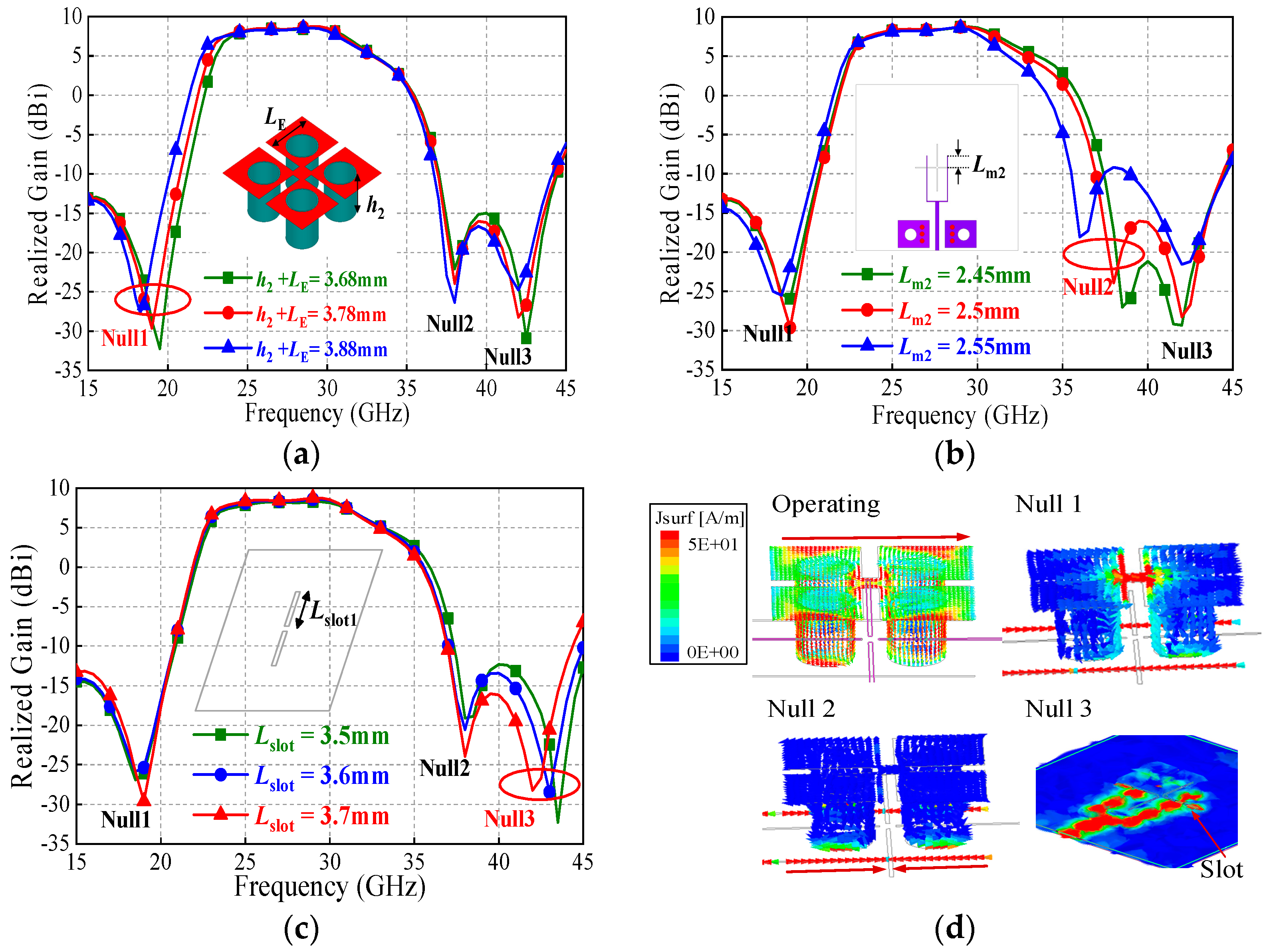

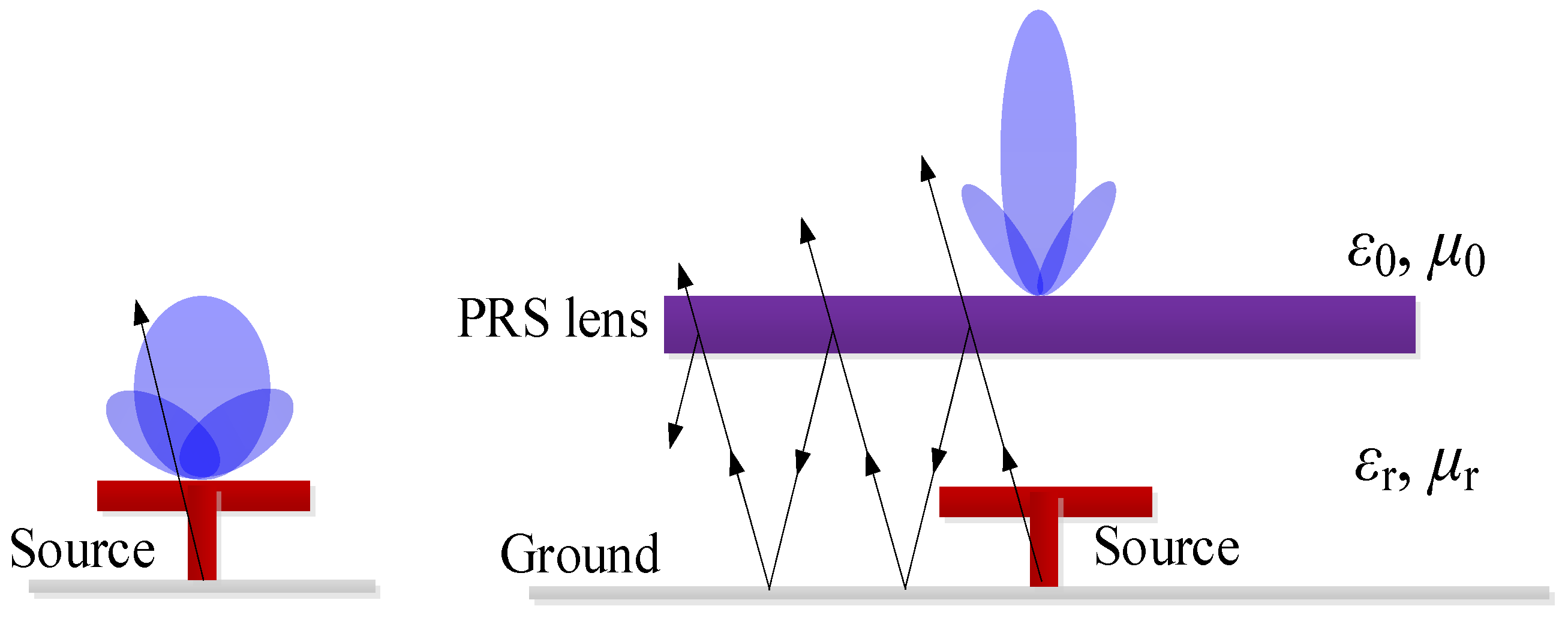
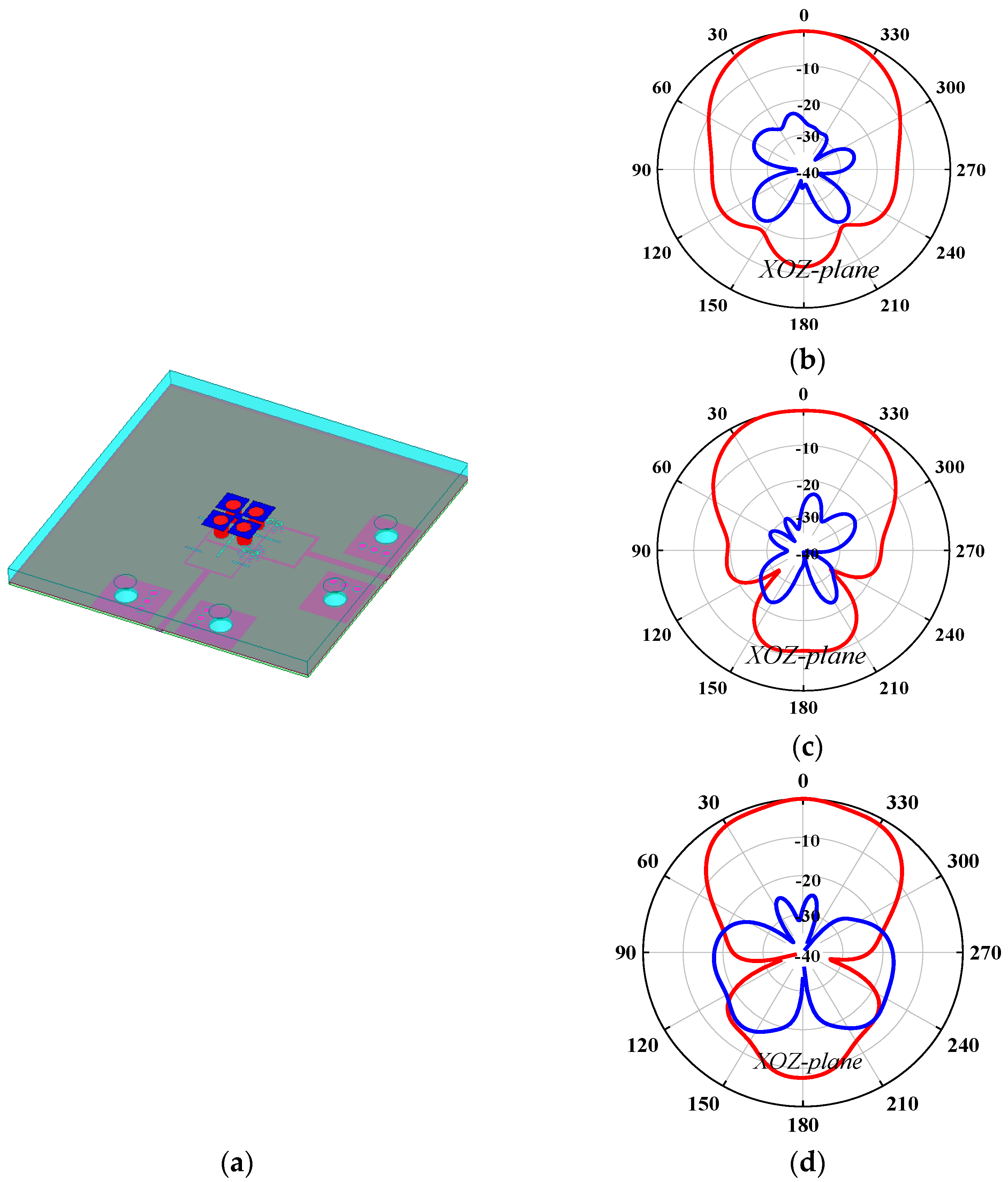
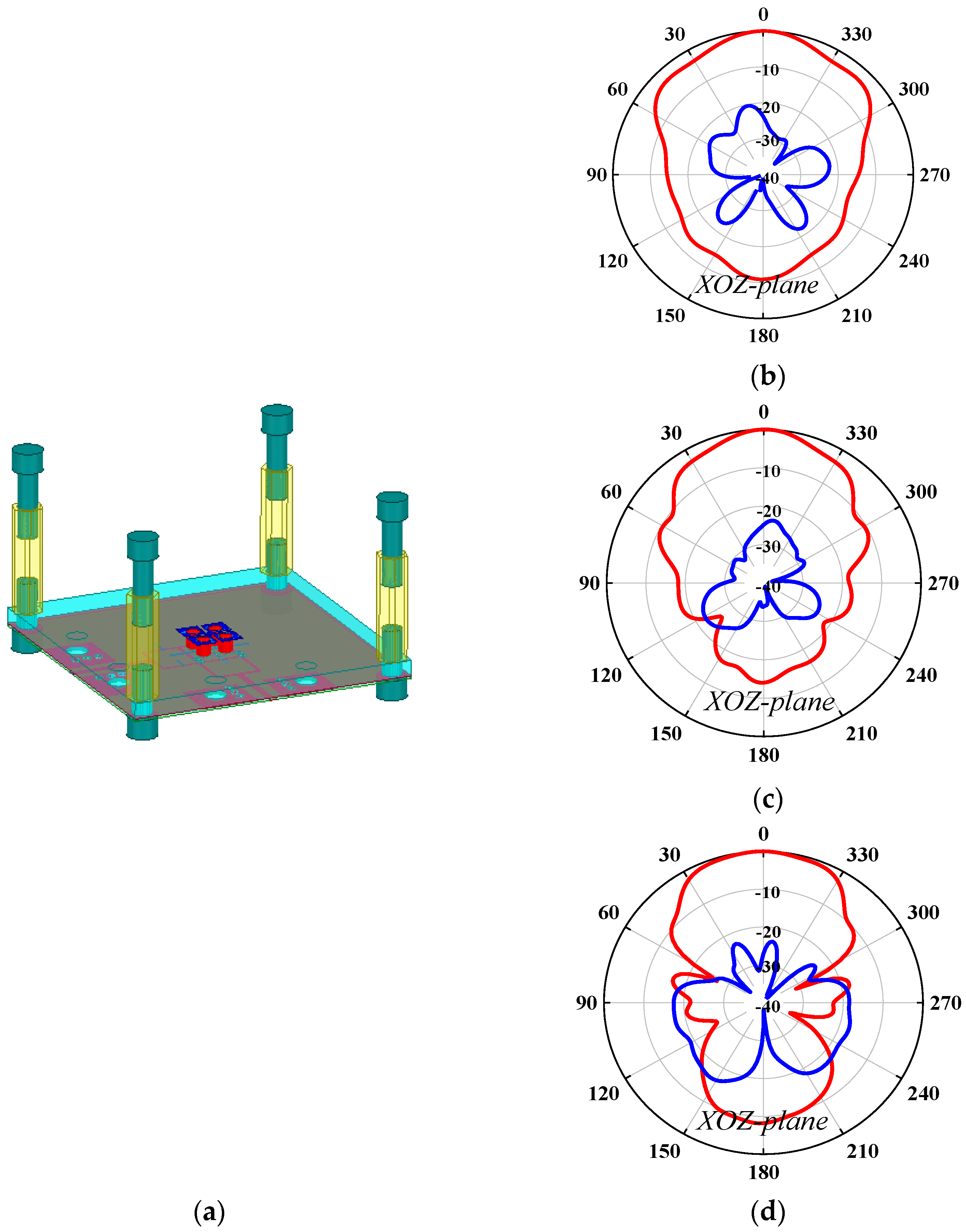

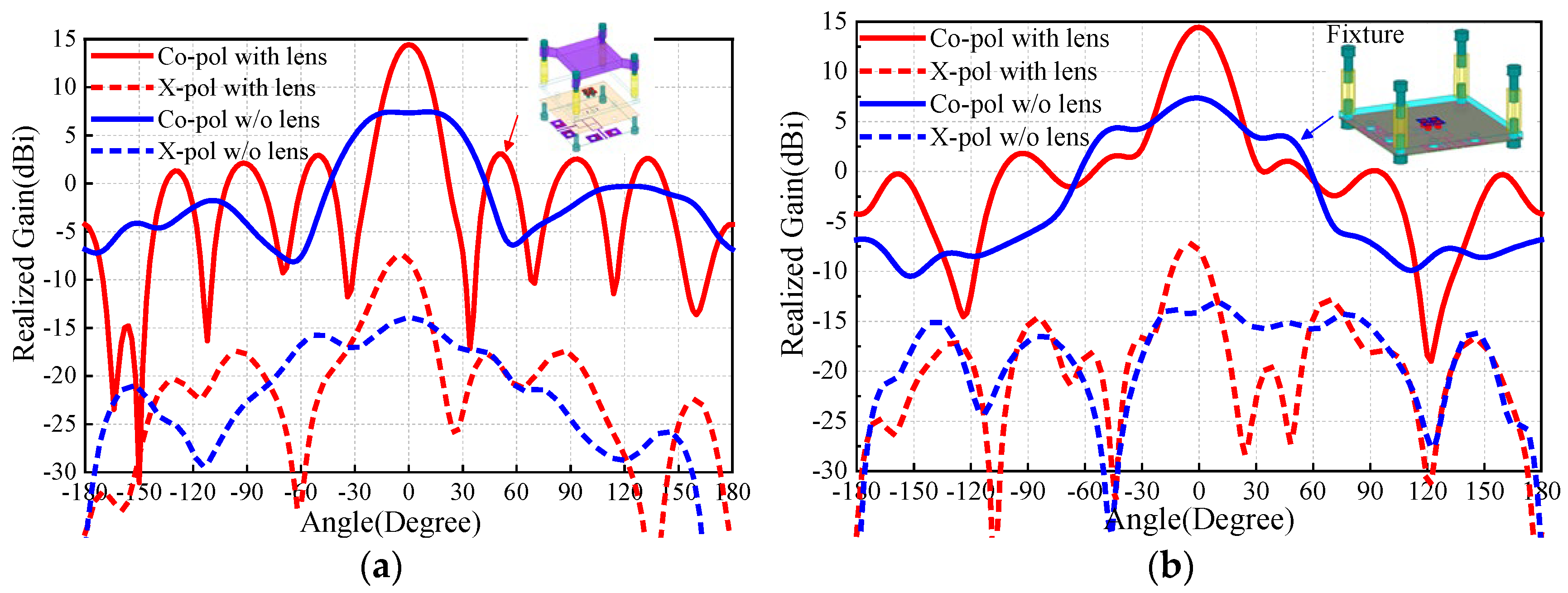
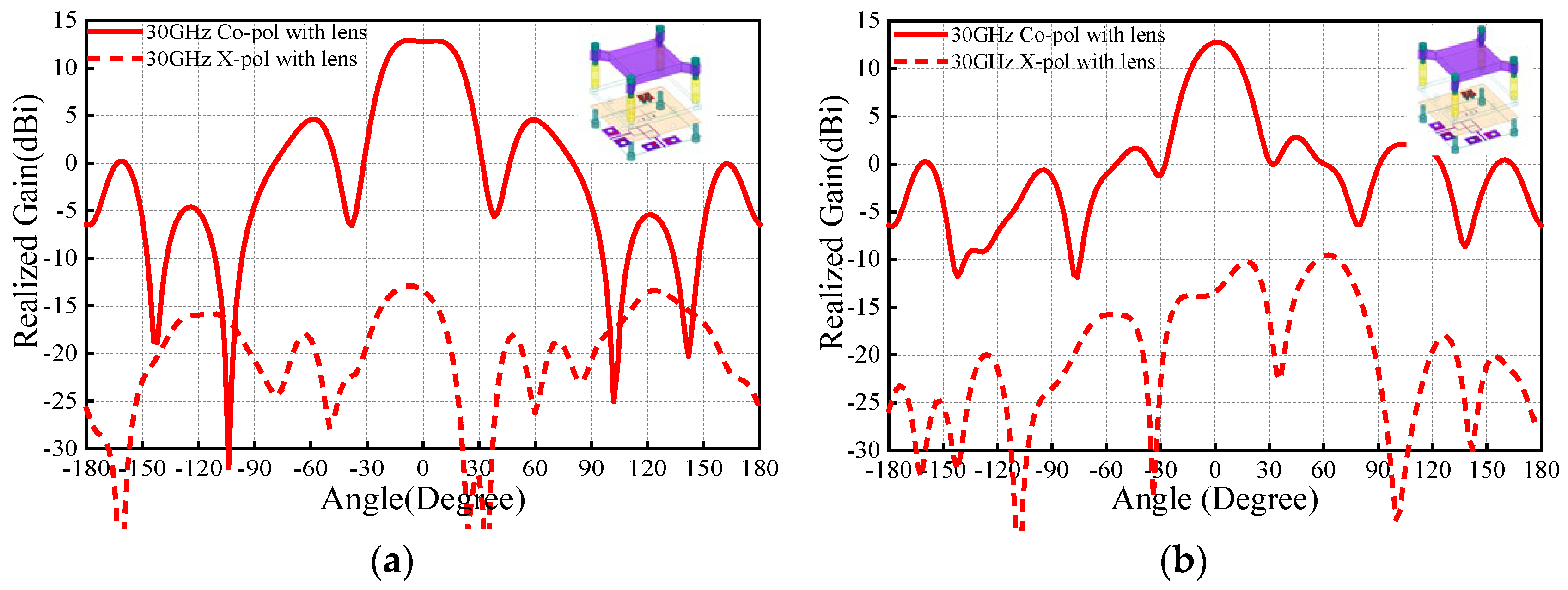
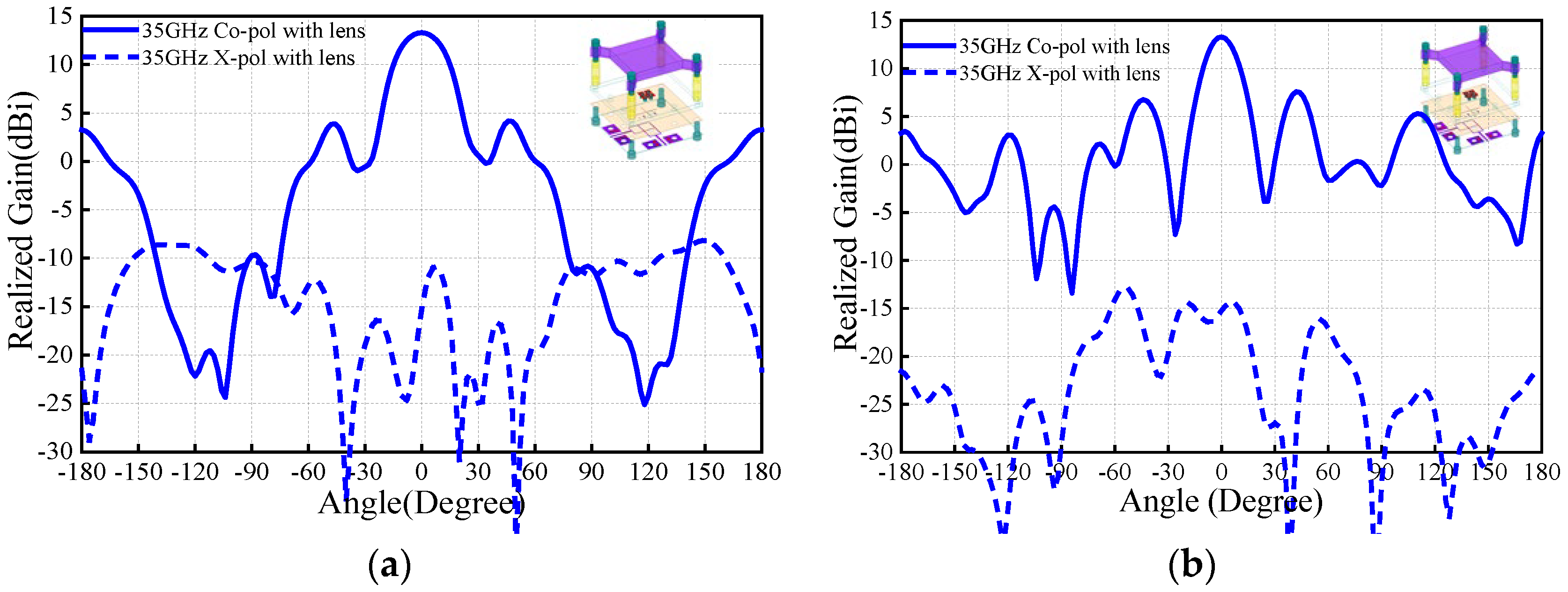

| L1 | L2 | L3 | L4 | L5 | L6 | L7 | L8 | L9 | L10 |
|---|---|---|---|---|---|---|---|---|---|
| 0.7 | 3.7 | 1.5 | 3.9 | 0.4 | 0.9 | 8.5 | 8.1 | 4.6 | 3.7 |
| L11 | L12 | L13 | L14 | L15 | L16 | L17 | L18 | L19 | L20 |
| 2.5 | 3 | 1 | 0.22 | 4.8 | 5.6 | 14 | 9.5 | 3.2 | 2.05 |
| Llens | h2 | W1 | W2 | W3 | W4 | W5 | W6 | W7 | d |
| 19.5 | 1.575 | 0.4 | 0.15 | 0.25 | 0.15 | 0.6 | 0.22 | 0.1 | 2.3 |
| LE | d | G | R1 | R2 | R3 | R4 | |||
| 2.2 | 2.3 | 25 | 0.7 | 1 | 1 | 0.4 |
Disclaimer/Publisher’s Note: The statements, opinions and data contained in all publications are solely those of the individual author(s) and contributor(s) and not of MDPI and/or the editor(s). MDPI and/or the editor(s) disclaim responsibility for any injury to people or property resulting from any ideas, methods, instructions or products referred to in the content. |
© 2025 by the authors. Licensee MDPI, Basel, Switzerland. This article is an open access article distributed under the terms and conditions of the Creative Commons Attribution (CC BY) license (https://creativecommons.org/licenses/by/4.0/).
Share and Cite
Zhang, Y.; Liu, H. Broadband High-Gain Dual-Polarized Filtering Antenna Using a Partially Reflective Surface Lens for 5G Millimeter-Wave Sensor Applications. Sensors 2025, 25, 6742. https://doi.org/10.3390/s25216742
Zhang Y, Liu H. Broadband High-Gain Dual-Polarized Filtering Antenna Using a Partially Reflective Surface Lens for 5G Millimeter-Wave Sensor Applications. Sensors. 2025; 25(21):6742. https://doi.org/10.3390/s25216742
Chicago/Turabian StyleZhang, Yao, and Huazhu Liu. 2025. "Broadband High-Gain Dual-Polarized Filtering Antenna Using a Partially Reflective Surface Lens for 5G Millimeter-Wave Sensor Applications" Sensors 25, no. 21: 6742. https://doi.org/10.3390/s25216742
APA StyleZhang, Y., & Liu, H. (2025). Broadband High-Gain Dual-Polarized Filtering Antenna Using a Partially Reflective Surface Lens for 5G Millimeter-Wave Sensor Applications. Sensors, 25(21), 6742. https://doi.org/10.3390/s25216742






